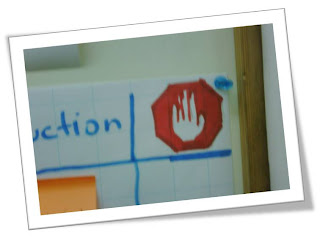Lets say we have a lot of issues
at hand, and we need to decide what to do first. The catch here is, that we
need to decide as a group (we’ve already discussed the
benefit of a group and empowerment before). The group leader (teacher/ manager)
agrees that the best way to have an assignment completed in the best possible
way, and get people highly motivated and have fun, will be to allow the
team/class to decide on their own.
But we have so many issues at
hand and only a short time frame to make our decision. So how are we all going to agree in, say, an
hour?
Imagine we are in a classroom
where the class has tons of many social assignments, from which they need to
pick just two activities that will benefit the entire school and probably win
them a prize. But again, there’s a catch. What if they don’t win? Well, even
then, at least they had fun and achieved the feeling of success and
accomplishment.
The technique, a simple sort of brain storm that I’ll
show you, is a very common "game" we play almost in every
implementation in the industry or wherever. In fact, I even remember playing it
when I was in the Girl Scouts.
So why not try it out at home or in the class room?!
So ,We have a huge list of idea
we want to achieve.
1.
Ask the each class/ team
member to offer two ideas and write them down on a sticky note.
Paint the school fence
Build a Muskie over in the lobby
Clean the tree area
Have an party during one of the breaks
Create an hour of fun for first grader
Build a coffee shop for the next parents day
**No one can object to a team
member idea at this point.
2.
Once every one is done ,
each team member has ten seconds to present his idea and place it on the board
in the order of its importance.
3.
If more then one team
members have the same idea, they add their note to the note already on the
board.
4.
Each team member in his
turn will add his note to the board and
place it according to the priority he thinks it has.
5.
The next step may be done in two different ways:
a.
The ideas that got the most votes are
selected.
b.
We can ask each team member
to grade the ideas 1-5, (or whatever points we like to use) and see what two
ideas got the most points.
6.
Discuss the ideas selected:
drill down into practical tasks.
7.
Examine again the effort of
this idea selected vs. the effort needed. Do we still want this idea or not?
The point is that
1.
We have an open discussion.
2.
Everybody’s ideas are visible.
3.
We select the ideas as a
group.
4.
We can change our mind
after we have selected an idea.
5.
And, we can do this
every time we have lots of things to do. A project can be a trip or a
birthday party , or an event or something we are planning to do, and there are
always more than one way to do things.
a.
Place the high priority
ideas higher , and the rest of assignments as a wish list inside your backlog.
b.
We now have a visibility
over more then only two things we wish to do.
A trip to San Diego

















